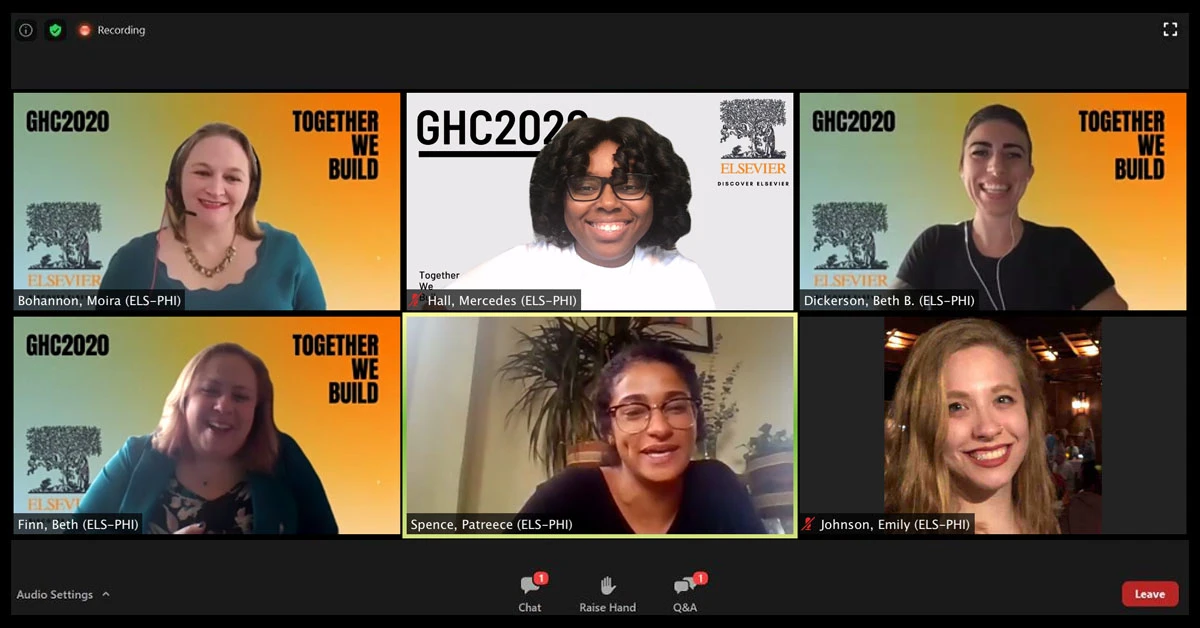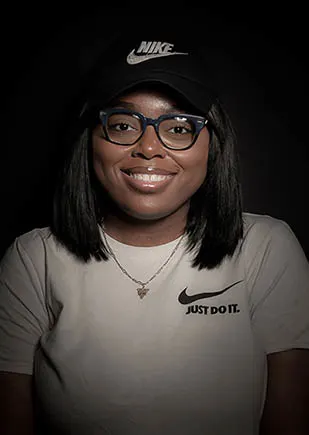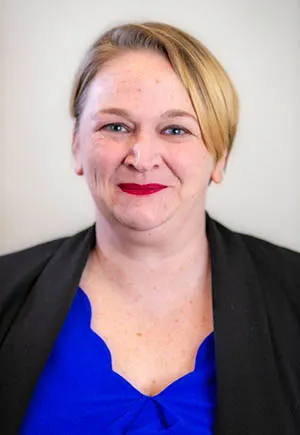How Employee Resource Groups can help build an inclusive culture
November 25, 2020
By Dwaraka Ganesan, Emily Johnson, Brittney Tuff, Linda Wogulis

Leaders of Employee Resource Groups at Elsevier share their tips and experiences at the virtual Grace Hopper Celebration.
Pictured above: In their panel titled “Breathing Life into ERGs: the Impact of a Pandemic and a Racial Justice Movement” at the virtual Grace Hopper Celebration, Elsevier’s Beth Dickerson, Moira Bohannon, Mercedes Hall, Patreece Spence and Beth Finn share their experiences and advice, and Emily Johnson facilitates the Q&A. If you’re looking to develop a more inclusive culture in your organization, one way is to start an Employee Resource Group (ERG). These voluntary, employee-led groups build support for employees with shared life experiences or characteristics, helping to foster a diverse workplace and provide support and visibility for employees.
When starting or maintaining a successful ERG, there are important elements to consider and skills to build. Whether you’re an ERG lead or a valuable member, focusing on these aspects can help you make an impact within your organization as a minority or an ally.
Last month, Elsevier presented an immersive panel discussion for women in technology at the virtual Grace Hopper Celebration for Women in Computing(opens in new tab/window), which brought together more than 30,000 women in tech from 115 countries. The event was named after the late mathematician Grace Hopper(opens in new tab/window), who was a Rear Admiral in the US Navy and a computer technology pioneer.
Elsevier’s panel — “Breathing Life into ERGs: the Impact of a Pandemic and a Racial Justice Movement” — featured leaders of various ERGs:
Moira Bohannon(opens in new tab/window), Developmental Editor, Co-Chair of Elsevier Pride Philadelphia
Mercedes Hall(opens in new tab/window), Software Engineer, Co-President of the African Ancestry Network Philadelphia
Patreece Spence(opens in new tab/window), Associate Publisher, Co-President of African Ancestry Network Philadelphia
Beth Finn(opens in new tab/window), Senior Project Manager, Clinical Solutions Precision Medicine portfolio, member and ally of Elsevier Pride, African Ancestry Network and Diversity in Tech
Beth Dickerson(opens in new tab/window) (moderator), Platform Advocate, Co-chair of Diversity in Tech
The panelists encouraged women in technology to create spaces in the corporate sector that foster a well-rounded work environment, empowering all employees to affect change and work to their full potential. They shared their journey of starting the Philadelphia chapter of the African Ancestry Network, an ERG for people of color and allies, from their motivations to create the group, to managing growth and integration within the larger organization. They also gave insights into navigating the leadership of an ERG with an acute interest due to the civil uprising and the new reality of remote collaboration.
The key points they discussed aligned with the theme of this year’s Grace Hopper Celebration: “Together We Build.” The theme reflects the idea that community, solidarity and collaboration are essential, particularly in the recent times of change. This idea extends to the creation and maintenance of successful ERGs:
Together …
Belonging
Employee Resource Groups have the unique ability to gather folks with important commonalities but who may not interact otherwise. The act of welcoming people and ideas can foster a sense of belonging in the workplace. When starting the Philadelphia chapter of African Ancestry Network, Mercedes Hall had an outpouring of positivity and support from both folks of African Ancestry and caring allies alike.
Mercedes recounted her experience:
At any point along the way, we always had each other and those guiding documents to lean on and regain focus. It was also super important that we kept open lines of communication between ourselves and our managers so that we could allocate time appropriately and have that time spent with ERG initiatives tracked. That way, later it can be factored into performance reviews. Overall, it was really beautiful to see the outpouring of positivity and support from both folks of African Ancestry and caring allies alike.
Groups like Pride and African Ancestry Network (AAN) enable stress reduction in an office setting. As ERGs are centered around various identity groups, employees have a company-supported starting point for finding a sense of belonging. ERGs are welcoming of new people and ideas and can lead to improved satisfaction in one's role and work.

Mercedes Hall
Events
Events are a key component of ERGs, and they provide opportunities for anyone to get involved. Since ERGs are connection points at work, we suggest trying different kinds of events to find out what engages your particular group. Engaging employees virtually in a COVID-19 world can be especially challenging. Whether starting or continuing an ERG, flexibility is key. Make your plans, then be ready to readjust.
Elsevier Pride had a fantastic slate of events planned for 2020 before the pandemic shifted everything. Virtual events have had varied success: there were a few where hardly anyone showed up, and others (like virtual Drag Bingo) that were quite successful. ERG leaders are still learning what works best. It can be a tricky balance to stay in touch but not contribute to Zoom fatigue. Trial and error can help determine what kind of events are most attractive, as well as staying flexible and adapting to the continual changes.
Moira recalled an experience that showcased the role of ERGs and their sponsored events in allowing employees to feel comfortable expressing themselves.
Having ERGs openly supported and celebrated allows people to bring their whole selves to work. After a June Pride event a few years ago, attended by nearly 100 people, a coworker came up to us and said they had never been out at work, and seeing the support for Pride made them comfortable to begin to come out here. I think it’s a really powerful statement that an ERG allowed someone to feel safe and be their authentic self at work.

Moira Bohannon
We …
Allies
Allies play an integral role in ERGs. Whether recruiting colleagues for events or helping take initiatives forward, allies can support their ERG leads, who manage the ERG while doing their full-time jobs. For example, some allies in the African Ancestry Network have started a virtual anti-racist book club. AAN has also collaborated with allies of RE Cares(opens in new tab/window) (our company’s global community volunteering program) to host a book drive highlighting minority authors and characters.
Are you hesitant to join an ERG as an ally? Moira stresses that all are welcome:
It’s important to us (ERG leads) to remind folks that allies are welcomed at all Pride events. We know that some people, especially new employees, aren’t sure if the group is for them if they don’t identify as part of the community, so we need to advertise beyond our email list and encourage anyone who supports the community to attend.
Community
Having a sense of community at work can be extremely beneficial. ERGs serve as a resource with the goal of empowering everyone to use their voices, find community, and celebrate our similarities and differences.
Starting the African Ancestry Network chapter in Philadelphia, Mercedes Hall and Patreece Spence recognized that there was a disparate group of people without a sense of community other than all being employed by the same company. AAN addressed that gap by providing an opportunity for them to come together and share experiences and recommendations while celebrating their unique culture.
As Moira explained:
Personally, I work on a small team with people based all over. So being in an ERG has given me a sense of community in the company beyond my day-to-day work. It provides an opportunity to learn about different products and teams and develop networking and personal relationships with coworkers. Having ERGs openly supported and celebrated allows people to bring their whole selves to work.

Patreece Spence
Build
Diverse talent
Beth Dickerson
As moderator, Beth Dickerson asked the panelists: “How have the ERGs helped to support our senior leaders during the many crises in 2020?”
Mercedes explained that one of the benefits of an ERG is having the ear of senior leadership. At Elsevier, this is very intentional. As every ERG has a senior leader liaison, Mercedes found this helpful when supporting her minority community. An ERG also gives a structure for folks to organize allowing more voices to make one statement as a body.

Beth Dickerson
With things like communications, program planning and coordination, and overall crisis response strategy, the presence of an ERG makes a world of difference. We can connect the needs of the employees directly to leadership and increase the sense of support employees feel. Creating community helps people to connect to resources and to have a sense of belonging, thereby strengthening the trust between senior leaders and folks working at Elsevier globally.
Shared resources
Whether building a new ERG or building up an established ERG, we know that it is built better together! Two parts to building a strong foundation are through sharing resources and through drawing from diverse talent.
There are a few ways to examine how we can share resources. If you want to leverage the resources of existing chapters, ask someone to do this with you! You double your network by adding it to someone else’s. Do not hold so tightly to your leadership structure that it becomes inflexible: allow it to change and grow as your group does the same. Perhaps your leadership member size needs to be increased. Or maybe the hierarchy structure needs to be flattened out. Reach out to your existing resources and your colleagues in HR. But before your group spreads its wings, make sure you provide yourselves a compass and a landing strip: set up your mission and vision statements.
The panelists
Moira Bohannon(opens in new tab/window) is Senior Editor on Elsevier’s Order Sets product, a global point of care application. She has served a co-chair of Elsevier Pride Philadelphia since 2016. She lives in Philadelphia with her son and cat.
Beth Dickerson(opens in new tab/window) is a Platform Advocate at Elsevier. In this role, she facilitates collaboration among front-end application and shared platform services teams. While working as a software engineer, she serves as a co-chair to Elsevier's Diversity in Tech ERG. Outside of the company, she co-organizes the LibertyJS tech conference and Philly JS Dev meetup. Her other job is taking her 12-year-old black lab, L, out for multiple walks around their Philadelphia neighborhood every day. L likes walks, rain or shine. Rain. Or. Shine.
Beth Finn(opens in new tab/window) is a Senior Project Manager for Elsevier’s Health Markets division. She gets to work with some of the smartest people she has ever met to build tools that help medical professionals make better decisions, manage patient data securely, and improve patient outcomes. She’s a fierce advocate for women and girls in STEM, the brain tumor community, and the city of Philadelphia, where she lives just blocks from the Liberty Bell.
Mercedes Hall(opens in new tab/window), a Chicago native and current Philadelphia resident, is a Software Engineer at Elsevier. Her primary role is to build dependable back-end systems to be used as shared platform services across the business. She is Co-President of the Philadelphia chapter of Elsevier's African Ancestry Network.
Contributors

DG
Dwaraka Ganesan
Application Production Support and Quality Manager
Elsevier

EJ

BT

LW